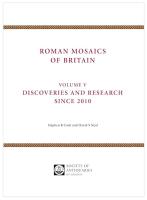
Society of Antiquaries of London (2024) h/b 287pp £95 (ISBN 9780854313068)
This massive four-volume set provides comprehensive coverage of all mosaics in the province of Britannia which were known up to 2010. This meant that ‘our’ Roman mosaics were better documented than those of any other province. Unfortunately for the authors of those four volumes, the work of property developers did not stop in 2010. Nor did the process of chance discoveries. The four volumes ceased to be comprehensive, as new mosaics came to light including some spectacular works. Hence the need for this book. Many known Roman sites that have been the subject of recent further investigation are also included. This was a substantial endeavour. Unquestionably, the top two discoveries are the mosaics at Ketton and Boxford.
In 2020 finds of pottery and other clues alerted a farmer at Ketton in Rutland to a possible Roman villa beneath his land. A geophysical survey revealed a substantial villa complex. It included a main building on the north side, a large aisled hall to the south, a separate bath house and other rectangular buildings. Parallel linear ditches surrounded the site. What sets this apart from most other villas is the spectacular set of mosaics which have survived. In a rectangular room, with an apse at the north end, three panels depict scenes from the Trojan War. Panel A shows Achilles and Hector in single combat. They ride in two-horse chariots and are hurtling towards each other. They are holding shields and brandishing spears. Achilles is not looking at Hector. He is looking sideways at the viewer: almost saying ‘Look at me, I’m going to win’.
Panel B shows the scene after the fight. Achilles is dragging Hector’s corpse behind his chariot. There is a kneeling figure on the right with arms outstretched, which must be Priam begging for the return of his son’s body. So far, so good. The pictures follow the well-known account in Iliad book 22. Panel C shows the weighing of Hector’s corpse. King Priam is standing on the right, wearing the same blue-grey tunic as in panel B. He is about to retrieve the body after paying its weight in gold. All in all, these are quite gruesome pictures to have on your sitting room floor.
People have known for 150 years that there was a Roman villa at Boxford in Berkshire, but there was no serious investigation of the site until 2017 when Cotswold Archaeology and others got to work. They uncovered a remarkable and well-preserved mosaic, depicting scenes from mythology. There are three or four such scenes in the central panel, separated by inscriptions in linear boxes. In one section we see Bellerophon riding on Pegasus (the winged horse), as he kills the Chimaera. The inscription above appears to read ‘BELLEREFONS’. Pegasus is in full flight, with his front legs extending into the frieze which surrounds the central panel. A separate scene shows the betrothal of Bellerophon to Philonoe, the daughter of king Iobates. This was his reward for slaying the Chimaera. The other half of the central panel shows a chariot race between Pelops and king Oenomaus. This was no ordinary sporting event. If Pelops won, he would be allowed to marry the king’s daughter, Hippodamia. But if he lost, he would suffer the same fate as previous suitors, namely execution. Between the two halves of the central panel are the remains of an inscription. It seems to wish Calpio, presumably the villa owner, and his wife a long life.
Both of the villa complexes discussed above date from the late fourth century. That was the golden age of villa culture, shortly before the collapse of Roman Britain. Romano-British élites enjoyed fine dining and elegant living, unaware of the chaos which lay ahead. They were well-versed in classical literature and loved mosaics to flaunt their knowledge. It is easy to imagine dinner parties in those settings. They were well-versed in classical literature and loved mosaics to flaunt their knowledge. It is easy to imagine dinner parties in those settings. Guests at Ketton might discuss book 22 of the Iliad over a glass or two of Italian wine.
This book does justice not only to the great discoveries at Ketton and Boxford, but also to all other ‘new’ mosaics. It is beautifully illustrated with photographs, diagrams and pictures. From that perspective, it could serve as a coffee table book. Indeed, this reviewer plans to keep it on a coffee table, at least for the time being, for the sheer pleasure of leafing through the mosaics.
But this work is in truth very much more than a coffee table book. It is packed with details, measurements and tables. It provides all the information that a scholar could need about any particular mosaic in which she or he is interested. There is also much comparison of the ‘new’ mosaics in Britain with others elsewhere around the Empire. In particular, the authors compare the British mosaics with those found in Belgic Gaul, Gallia Belgica.
I unhesitatingly commend this book to classicists, both as a delightful account of the latest Roman mosaics found in Britain and as a serious work of scholarship.
Rupert Jackson
